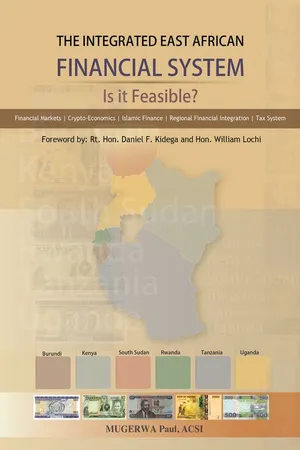
- 702 pages
- English
- PDF
- Available on iOS & Android
About this book
As the EAC regional bloc is soon celebrating 20 years since its inception, is it any closer to being fully integrated? Is the regional financial integration still feasible? How can it work for every member State and every East African? How can other RECs learn from the EAC experience? What should be further considered to optimise the business sense in the entire financial integration drive? In an analysis of more than 70 financial and other institutions the author addresses the levels of financial inclusion, financial system development, and regional integration to assess the feasibility of a financially integrated EAC and provides benchmarks which inform policy. The author explores not only conventional finance and banking but also introduces one area that is usually not captured in most writings and books in this areas i.e. Islamic Finance. While Islamic Finance is slowly becoming a mainstream area of finance, there has been limited research, works and writing in the area.
Frequently asked questions
- Essential is ideal for learners and professionals who enjoy exploring a wide range of subjects. Access the Essential Library with 800,000+ trusted titles and best-sellers across business, personal growth, and the humanities. Includes unlimited reading time and Standard Read Aloud voice.
- Complete: Perfect for advanced learners and researchers needing full, unrestricted access. Unlock 1.4M+ books across hundreds of subjects, including academic and specialized titles. The Complete Plan also includes advanced features like Premium Read Aloud and Research Assistant.
Please note we cannot support devices running on iOS 13 and Android 7 or earlier. Learn more about using the app.
Information
Table of contents
- Cover
- Title page
- Copyright page
- ABOUT THE AUTHOR
- SUMMARY OF CONTENT
- CONTENTS
- ACKNOWLEDGEMENTS
- DEDICATION
- BOOK REVIEWS
- PRELUDES
- PREFACE
- Part One - FINANCE IN A FINANCIAL SYSTEM
- PART 2 - ISLAMIC FINANCIAL SYSTEM in EAC
- Chapter seven - FUNDAMENTALS OF IFS
- Chapter eight - IFS Operations
- DEDUCTION of Part 2
- PART 3 - FINANCIAL INSTITUTIONS
- Chapter nine - BANKING FINANCIAL INSTITUTIONS
- i) Historical Background of the Banking sector in EAC Region (A case for Uganda)
- i) The Four Tiers in the Banking Sector
- Tier I – Commercial Banks
- a) Non-Performing Loans
- b) Private Sector Credit
- Why EAC has High Interest Margins?
- c) Commercial Banks Weighted Average Deposits & Lending rates
- d) EAC Currencies Depreciation
- U.S Economy Rebound in 2015
- Exchange Depreciation Effects on the Banking System
- a) Capital Adequacy Ratio
- Advantages of Commercial Banks
- Tier II - Financial Institutions
- Advantages of Credit Institutions
- Tier III - Financial Institutions
- Advantages of MDIs
- Tier IV - Institutions
- Advantages of SACCOs and MFIs in East Africa
- iii) Retail Banking
- v) International Banking (Eurocurrency/ Offshore banking)
- vi) Development banking
- EAST AFRICAN DEVELOPMENT BANK
- WORLD BANK GROUP
- Impact on the EAC Region
- Exposure in Sub-Saharan Africa
- vii) Role of Banking System in Economic development/ Financial deepening of EAC Region
- viii) Factors responsible for the growth of the Banking Sector
- ix) Financial Innovations & Inclusion
- Chapter ten - EAC INSURANCE INDUSTRY
- Insurance industry in the EAC
- Elements of a Well-Functioning Insurance markets
- OTHER NEW DEVELOPMENT IN EAC INSURANCE SECTOR
- CHALLENGES TO THE INSURANCE INDUSTRY
- Background
- Challenges
- GLOBAL HISTORICAL INSURANCE FACT FILES
- Conclusion
- Chapter eleven - OTHER NON-BANK FINANCIAL INSTITUTIONS
- i) Types of NBFI
- Building Societies
- Savings and Credit Cooperatives (SACCOs)
- Discount Houses
- Private Equity Investment
- Sovereign Wealth Funds
- Asset/fund Managers
- Chapter twelve - SOCIAL SECURITY SYSTEMS IN EAC
- Feature: NSSF-UGANDA PERFORMANCE during its 30 years of Existence
- a) Total Assets